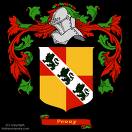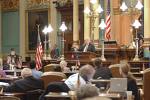The Perry Surname and Homeopathy
February 14, 2008
 The Perry surname has also
contributed some famous homeopaths. Charles Perry was
mentioned as a homeopath in the The Michigan University Book.
1814-1880.
The Perry surname has also
contributed some famous homeopaths. Charles Perry was
mentioned as a homeopath in the The Michigan University Book.
1814-1880.
 Gideon D.
Perry** **1811 -
was a preacher who had to retire due to poor health until he was cured
by homeopathy. He then trained as a homeopath and became the first
person to introduce the system of homeopathy in
Michigan.
Gideon D.
Perry** **1811 -
was a preacher who had to retire due to poor health until he was cured
by homeopathy. He then trained as a homeopath and became the first
person to introduce the system of homeopathy in
Michigan.
In 1856 Perry was elected a member of the House of Representatives of the Michigan legislature, and in 1858 he was elected a member of the state senate, and served upon important committees.
Gideon D. Perry was born in Palmyra, Wayne County, New York, October 25, 1811. He left his father’s home when he was nineteen years old. He had been brought up a. farmer, but after leaving home he commenced teaching and going to school, and so continued until 1833, when he commenced preaching, and was admitted to the Genesee conference of the Methodist Episcopal church.
He preached for about eleven years, when, owing to poor health, he was compelled to give it up.
In 1843 he came to Michigan and settled on section 26, in Franklin, on a new farm, where he resided the remainder of his life.
He was the first to introduce the system of homeopathy in Michigan. In the spring of 1856 he was elected supervisor of Franklin, and every vote polled for supervisor in the township was cast for him. He was elected Chairman of the Board that year.
In the fall of 1856 he was elected a member of the House of Representatives of the Michigan Legislature. In 1858 he was elected a member of the State Senate, and served upon important committees.
After taking up his residence in Michigan he preached more or less every year, and during the first few years he officiated at many funerals.
He became acquainted with Dr. Hall and was largely instrumental in inducing him to adopt the homœopathic practice. Mr. Perry also persuaded Dr. Thomas Blackwood of Plymouth, Wayne county, to test the truth of the new practice, with the result that he soon became an avowed follower of the doctrines of Hahnemann.
In a visit to a patient Dr. Blackwood met Dr. Lamb and the result of the treatment caused the latter to espouse the new cause. Mr. Perry was a zealous missionary of homœopathy and made many converts. He was of value in assisting young physicians, and was held in great esteem. He is said to have been a skillful prescriber…
Besides the regularly educated physicians who had become converts to the mild system of medicine, there were several laymen who procured Constantine Hering’s “Domestic Practice” (The Homeopathic Domestic Physician) and some homœopathic remedies for use in the then sparsely settled towns in which they lived, and were wont to prescribe for their neighbors.
Among them were the Rev. Mr. Kanosh of Washtenaw county, Rev. J. N. Reed, H. C. Knight, and Rev. Mr. Perry, of whom mention has been made.
Prior to 1850, the University of Michigan in its various incarnations was a product of the Michigan Legislature (or its territorial equivalents), and the Board of Regents and its predecessors were subject to oversight and control by the Legislature.
The state constitution of 1850 elevated the Board of Regents to the level of a constitutional corporation, making the University of Michigan the first public institution of higher education in the country so organized. The Legislature did not give up its control easily, and the Board of Regents engaged in a number of battles with legislators before the matter was settled, several of them involving the establishment of a school of homeopathic medicine.
In 1851, a group of citizens who supported the homeopathy movement petitioned the Legislature of the University of Michigan to force the Board of Regents to add professors of homeopathy to the medical school staff. The board took no action, but Dr. Zina Pitcher wrote a detailed account of their thinking to leave for their incoming replacements (the first class of elected regents in 1852):
...shall the accumulated results of three thousand years of experience be laid aside, because there has arisen in the world a sect which, by engrafting a medical dogma upon a spurious theology, have built up a system (so-called) and baptized it Homœopathy?
Shall the High Priests of this spiritual school be specially commissioned by the Regents of the University of Michigan, to teach the grown up men of this age that the decillionth of a grain of sulphur will, if administered homœopathically, cure seven-tenths of their diseases, whilst in every mouthful of albuminous food they swallow, every hair upon their heads, and every drop of urine distilled from the kidneys, carries into or out of their system as much of that article as would make a body, if incorporated with the required amount of sugar, as large as the planet Saturn?
Nevertheless, the University of Michigan did eventually become homeopathic in 1875:
The homeopathy collection at the Taubman Medical Library of the University of Michigan originated in the holdings of the Homeopathic Medical College, first established as part of the University in Ann Arbor in 1875 and conducted concurrently with the allopathic Medical School until 1922.
The collection itself contains items dating from the mid-1800’s to the present day. Of particular interest is the Bradford Homeopathy Collection, which is composed of 1027 pamphlets that detail 75 years of the history and development of the field of homeopathic medicine.
Along with the holdings of the former Homeopathic Library, these pamphlets constitute one of the world’s most complete collections on the subject.
For more information on the Taubman Homeopathy Collection, please consult the Homeopathy Collection Guide.
Members of the Rochester City Hospital Training School for Nurses who became physicians, in the back row, Elizabeth Campbell, Mary Emma Dickinson, Kate A. Hathaway Salmon.
In the front row are: A. Josephine Sherman-Buckley, Sarah H. Perry, and Marcena Sherman-Ricker… Dr. Perry graduated from the Buffalo Medical School in 1882 and entered the Training School; since women were not allowed to be interns in hospitals they often joined nursing programs to get the necessary clinicals.
